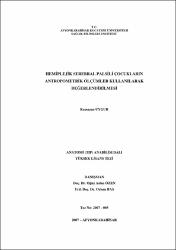Hemiplejik Serebral Palsili Çocukların Antropometrik Ölçümler Kullanılarak Değerlendirilmesi
Abstract
Serebral palsi gelişimini tamamlamamış beyin dokusunun ilerleyici olmayan
bir hastalığının sebep olduğu, kalıcı ancak değişime uğrayabilen hareket ve postür
bozukluğunun görüldüğü nörogelişimsel bir yetersizliktir. Beyindeki lezyon
sonucunda istemli motor aktivitelerde ve duyusal fonksiyonlarda yetersizlikler ortaya
çıkar, kas tonusu ve koordinasyonunda sorunlar oluşur, zamanla kas iskelet
sisteminde ikincil bozukluklar da gelişir. Hemiplejik serebral palsi’de gövdenin sağ
veya sol yarısını içeren belirgin hemipleji veya hemiparezi mevcuttur. Karsı taraf
fonksiyonları ise değişik düzeylerde etkilenir ve genelde tam bir yeterliliğe sahip
değildir.
Antropometri; tüm yas gruplarında insan vücudunun nesnel özelliklerini
belirli ölçme yöntemleri ve ilkeleri ile boyutlarına ve yapı özelliklerine göre
sınıflandıran, sayısal olarak ifade eden, belirli özelliklerini inceleyerek standartlarını
belirleyen, bireyler ve gruplar arasındaki farklılıkları ortaya koyan yöntemdir.
Çalışmamızdaki amacımız serebral palsinin çocukların büyüme ve gelişmesi
üzerine olan etkisini incelemek amacıyla hemiplejik serebral palsili çocukların
antropometrik ölçümlerini yaparak, sağlam tarafı ile plejik tarafı arasındaki
gelişimsel farklılıkları bulmak ve normal çocukların antropometrik ölçümleri ile
karşılaştırmaktı. Bu amaçla hemiplejik serebral palsili çocukların plejik taraf ve
sağlam tarafı ile aynı yas grubundaki normal çocukların antropometrik ölçümlerini
yaptık. Çalışmamızın sonucunda hemiplejik serebral palsili çocukların plejik taraf
antropometrik değerlerinin sağlam taraf antropometrik değerlerinden düşük olduğunu
saptadık. Normal çocukların antropometrik ölçümleri ile karşılaştırdıgımızda ise
hemiplejik serebral palsili çocukların sağlam ve plejik taraf antropometrik
değerlerinin düşük olduğunu gözlemledik. Cerebral palsy is a neuro-developmental disorder resulting from nonprogressive
injury of immature brain tissue. Permanent and changeable movement
disorders and impairment of posture are also seen in cerebral palsy. Brain lesion
results in impairment of voluntary motor activity and sensory functions. Problems
arise in tonus and coordination of muscles and in time secondary musculoskeletal
deficits develop. There is marked hemiplegia or hemiparesis involving right or left
side of the body in hemiplegic cerebral palsy. The degree of the functional
impairment of the opposite side vary and usually the opposite side is not completely
normal.
Anthropometry is a method which classifies objective characteristics of the
human body in all age groups according to its dimensions and structural properties
by using certain measuring methods and principles and expresses the results
quantitatively. It sets the standards of the body by examining its certain
characteristics and demonstrates the differences between individuals and groups.
Our aim in this study was to make the anthropometric measurements of the
children with hemiplegic cerebral palsy in order to investigate the effect of cerebral
palsy on the physical development of children and thus to discover the
developmental differences between the healthy side and the plegic side and to
compare them with the anthropometric measurements of the normal children. We
made the anthropometric measurements of the plegic side and the healthy side of the
children with hemiplegic cerebral palsy and of the normal children in the same age
group. We observed that the anthropometric values of the plegic side are lower than
those of the healthy side in children with hemiplegic cerebral palsy and the
anthropometric values of both the plegic and healthy sides in children with
hemiplegic cerebral palsy are lower than those of the normal children.
Collections
- Yüksek Lisans Tezleri [635]



















